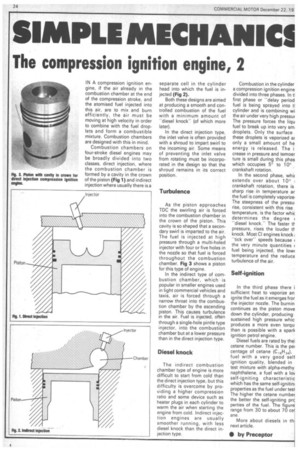SIMPLE MECHANICS
Page 26

If you've noticed an error in this article please click here to report it so we can fix it.
The compression ignition engine, 2
IN A compression ignition engine, if the air already in the combustion chamber at the end of the compression stroke, and the atomised fuel injected into this air, are to mix and burn efficiently, the air must be moving at high velocity in order to combine with the fuel droplets and form a combustible mixture. Combustion chambers are designed with this in mind.
Combustion chambers on four-stroke diesel engines may be broadly divided into two classes, direct injection, where the combustion chamber is formed by a cavity in the crown of the piston (Fig 1) and indirect injection where usually there is a separate cell in the cylinder head into which the fuel is injected (Fig 2).
Both these designs are aimed at producing a smooth and controlled combustion of the fuel with a minimum amount of "diesel knock(of which more later).
In the direct injection type, the inlet valve is often provided with a shroud to impart swirl to the incoming air. Some means of preventing the inlet valve from rotating must be incorporated in the design so that the shroud remains in its correct position.
Turbulence
As the piston approaches TDC the swirling air is forced into the combustion chamber in the crown of the piston. This cavity is so shaped that a secondary swirl is imparted to the air. The fuel is injected at high pressure through a multi-holed injector with four or five holes in the nozzle so that fuel is forced throughout the combustion chamber. Fig 3 shows a piston for this type of engine.
In the indirect type of combustion chamber, which is popular in smaller engines used in light commercial vehicles and taxis, air is forced through a narrow throat into the combustion chamber by the ascending piston. This causes turbulence in the air. Fuel is injected, often through a single-hole pintle type injector, into the combustion chamber but at a lower pressure than in the direct injection type.
Diesel knock
The indirect combustion chamber type of engine is more difficult to start from cold than the direct injection type, but this difficulty is overcome by providing a higher compression ratio and some device such as heater plugs in each cylinder to warm the air when starting the engine from cold. Indirect injection engines are usually smoother running, with less diesel knock than the direct injection type.
Combustion in the cylinder a compression ignition engine divided into three phases. In t first phase or "delay period fuel is being sprayed into tl cylinder and is combining wi the air under very high pressur The pressure forces the liqu fuel to break up into very srn droplets. Only the surface these droplets is vaporized ar only a small amount of he energy is released. The i crease in pressure and temoer ture is small during this phas which occupies 50 to 10° crankshaft rotation.
In the second phase, whic extends over about 10° crankshaft rotation, there is sharp rise in temperature ar the fuel is completely vaporizel The steepness of the pressu rise, consistent with this rise temperature, is the factor whir determines the degree 1 "diesel knock.The faster tlpressure, rises the louder th knock. Most Cl engines knock "tick over" speeds because 1 the very minute quantities fuel being injected, the lowt temperature and the reduce turbulence of the air.
Self-ignition
In the third phase there i sufficient heat to vaporize an ignite the fuel as it emerges from the injector nozzle. The burnin continues as the piston move down the cylinder, producing sustained high pressure whic produces a more even torqu than is possible with a spark ignition petrol engine.
Diesel fuels are rated by the cetane number. This is the pet centage of cetane (C181-I34), fuel with a very good sell ignition quality, blended in test mixture with alpha-methy naphthalene, a fuel with a lo% self-igniting characteristic which has the same self-ignitint properties as the fuel under test The higher the cetane number the better the self-igniting prc perties of the fuel. The figure range from 30 to about 70 cei ane.
More about diesels in th next article.
• by Preceptor




































































